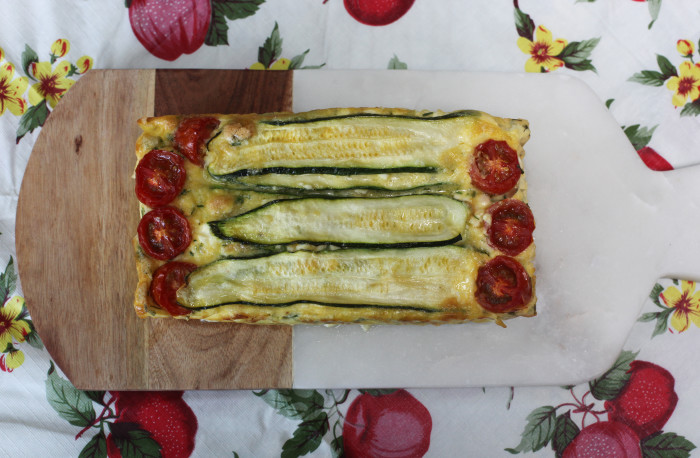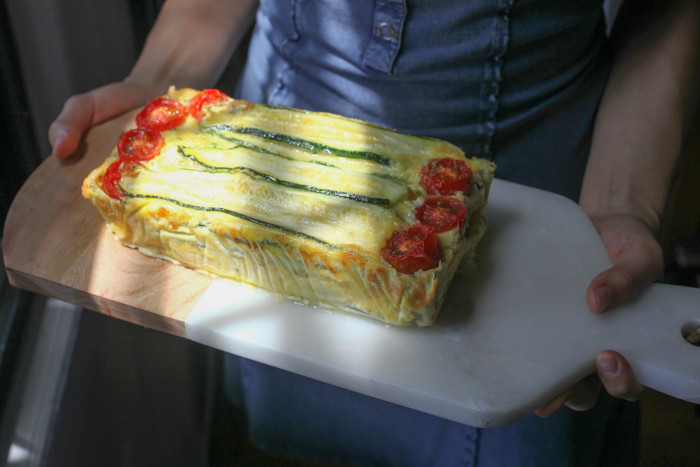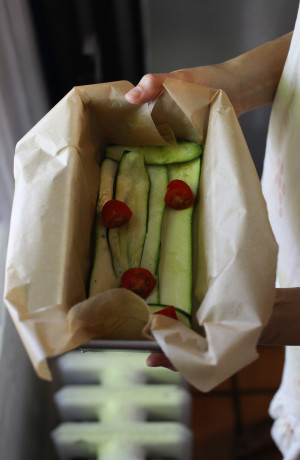summer squash terrine
by sanae
I have terrible memories from my childhood of fish terrines: cold and gritty mousse, a brown gelatin that wobbled around the edges. I doubt these terrines were bad, but they were always served as an appetizer during Christmas Eve, and only delayed the excitement of a tender chicken stuffed with roasted chestnuts and stewed prunes. I would smother my half-slice with a rich sauce until I was eating what tasted like pure mayonnaise. No wonder my stomach churned when I saw the white and orange terrine at the center of our table.
I’ve always loved a meat terrine where its irregular, rust-colored surface is almost like mountain terrain, and its moist interior is best sliced onto bread and eaten with cornichons. And slowly I’ve come to appreciate fish terrines, with much less sauce, and not when I’m hungering for a whole chicken.
But this month of May, the vegetable terrine has caught my attention. The one I’ve made a few times these past weeks is delicate and creamy. It is a cross between a terrine and a savory clafoutis, with a silky custard that barely binds the vegetables together.
What is a terrine? Well, it’s the rectangular earthenware container in which you cook your terrine. It’s the mold and its yield.
Let me tell you about this recipe, and why you should hurry to your oven while mild weather in New York still permits. Its texture is soft, with dense pockets of cream cheese, slivers of zucchini and hot sweet tomatoes, bursting under your teeth. The cream and egg filling is unobtrusive, allowing an otherwise self-effacing zucchini to shine through.
First, I slice the zucchini lengthwise, very thinly, and salt the strips to remove moisture and to quick-pickle. (The first time around I failed to do this and my terrine cooked in a swamp of vegetable liquid, and while delicious, it sweated all over our table). After twenty-minutes, the zucchini glistens with water, which I wipe off with a paper towel or remove by pressing the strips into a strainer. The zucchini will retain a sharp saltiness when buried in the egg and cream filling of the cooked terrine.
The cherry tomatoes must be very ripe so the top layer caramelizes. If they are too big, slice them in half. Think about arranging your vegetables with care and order. The beauty of the terrine is in its proud, textured crest: this is your blank canvas, where you can be playful with how you arrange your tomatoes and zucchini. The inside is mysterious, and reveals its layers of green, red, and white only when sliced. When you serve your guests, it is like unwrapping a gift. Asparagus work particularly well: long and crisped on the top, plump and round like pennies in the middle.
The grated Parmesan (a good kind, grated the day-of) gives the terrine a more complex and savory depth, and the chives provide color and bite. No need to overbook your terrine: salt and pepper suffice.
Forty or so minutes into cooking, I brush the top layer with olive oil, and then dust with a flaky salt.
You should cook your terrine in a pre-heated oven, for as long as it takes to achieve golden blisters on your zucchinis and tomatoes. For my oven this means almost an hour. Yours might take 40 minutes.
Of course you can experiment with fillings: sun dried tomatoes and goat cheese, eggplants and tomatoes, asparagus. But I’m quite taken with zucchini recently (on the grill until it is zebra striped and melting), and after reading what Deborah Madison has to say in her beautiful Vegetable Literacy cookbook, I’ve grown even fonder of the green squash.
Deborah Madison was once terrified of zucchini because of squash bugs. She writes, “Squash bugs are supercreepy. They smell bad. They produce scads of hideous gray babies. They dwell in the base of your plant and sit there until you come along looking for a squash, then they slowly slither off. (…) It is disheartening to come across your squash and see their once noble leaves ragged and limp, their stalks collapsed.”
Thankfully, she discovered the trick to planting and harvesting squash in the later summer months (July), when there are fewer bugs and she can overcome her great fear of those stinky creatures. Cooking squash for a long time brings its squashiness out – a more distinct, strong flavor, because otherwise summer squash can be rather bland, albeit the perfect backdrop for creative seasoning and summer herbs.
Recipe adapted from Saveurs Numéro 212
Ingredients:
2 small zucchinis
A handful of cherry tomatoes
A handful of chives, chopped
4 eggs
40 g Parmesan, grated (about 1 cup, very loosely packed)
3/4 cup heavy cream
120 g cream cheese, full fat, at room temperature
Salt and pepper
Olive oil to brush top layer
Directions:
Preheat oven to 350F.
Cut the zucchinis into thin strips with a mandolin or a very sharp knife. Spread in one layer on two large plates and sprinkle with salt. Let sit for twenty or so minutes until the zucchini has sweated. Wipe water with a paper towel or press the zucchini strips into a colander over the sink.
In a large bowl, stir eggs and grated Parmesan. Add cream cheese and stir again until the cheese is mostly incorporated (don’t worry about the pearl-sized chunks). Add chives and salt and pepper.
Line a rectangular cake mold with parchment paper. Cover the bottom with a layer of zucchini and a few tomatoes. Pour 1/3 of the cream and egg filling. Add a second layer of zucchini and a few tomatoes. Repeat previous steps. The top layer will be of zucchini and tomatoes. Bake for 40-60 minutes. Remember to brush the top layer with olive oil and sprinkle with salt a half hour in.
You can eat the terrine chilled, but I recommend letting it sit at room temperature for an hour, and then serving it on small plates. I find I’m able to better appreciate the gentle flavors when they are warm, rather than cold. Like sushi rice, the terrine is best served at body temperature.



